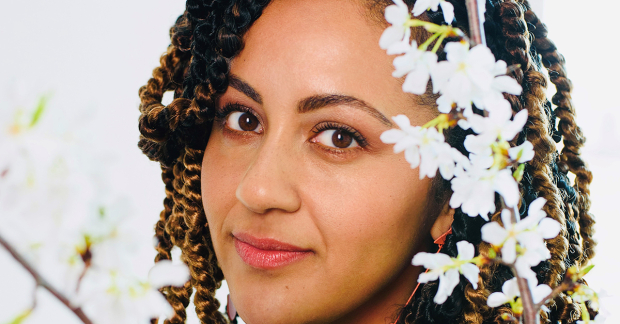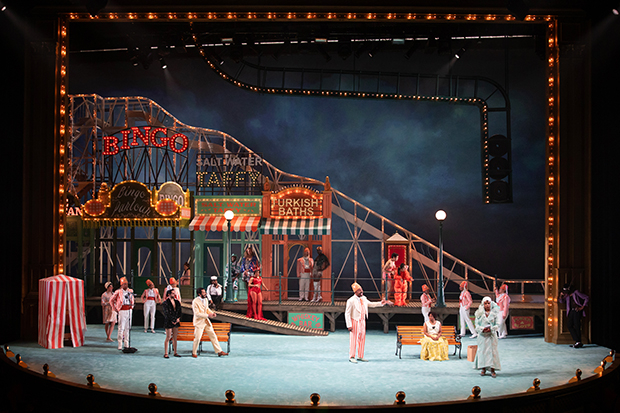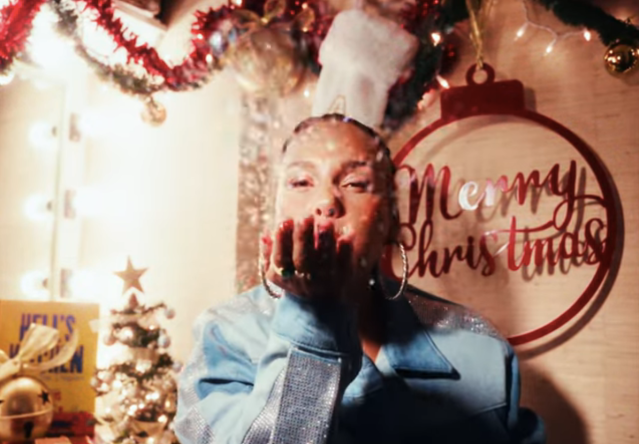"Scale Is Part of the Story": Lileana Blain-Cruz on Staging the New Skin of Our Teeth
Blain-Cruz directs the Thornton Wilder classic at the Vivian Beaumont Theater.
One of the most remarkable aspects of Lileana Blain-Cruz's new Lincoln Center Theater revival of Thornton Wilder's The Skin of Our Teeth, beyond the fact that it's her Broadway debut after setting the theatrical world on fire with her productions of Anatomy of a Suicide and Fefu and Her Friends and Revolt. She Said. Revolt Again., beyond the fact that there are 19 Broadway debuts on the stage of the Vivian Beaumont Theater, is its size.
The Skin of Our Teeth is perhaps the biggest non-musical in that space since Act One, and even dwarfed some of the musicals that have come since, with the possible exception of the ship at the beginning of The King and I. There's a dinosaur puppet whose tail swings across rows of seats, a movie screen that almost feels like it could be IMAX, and a full-sized amusement park slide that extends from the flies to the stage deck.
I tell Blain-Cruz that I clapped like a trained seal and she was delighted. "Scale is part of the story," she says, and the directors worked their asses off to bring her vision for Wilder's 1942 Pulitzer Prize winner to life. It features an all BIPOC company and presents the script in its full three-act, three-hour glory, with minor alterations by one of her close collaborators, Branden Jacobs-Jenkins, to align the piece with the makeup of her company.
I also told her I wanted to live in her brain for five minutes to see what that level of creativity was like. This is as close as I got, and it was worth it.

(image provided by Lincoln Center Theater)
This interview has been condensed and edited for clarity.
Why The Skin of Our Teeth and why now?
I had the rare experience to be planning something while still in the midst of the pandemic, with the onus of actually being able to think about what people would be returning to see. The Skin of Our Teeth resounded for so many reasons: Fundamentally, what does it mean to be alive, what does it mean to be on the brink of the apocalypse over and over again, and the recognition that humanity has been on the brink of apocalypse over and over again and we've managed to survive. I was just so moved by the recognition of the struggle of what it means to exist, and at the same time, the persistent hope that we can move through even the darkest of times. That was the heart journey to the play.
My association with Wilder came relatively late. There's a thought of him being an older white guy playwright, but it was fun for me to think about the fact that he was so experimental. He was a huge inspiration for absurdism in the theater, so to reexcavate this play in relationship to his own experimental inclinations was really exciting for me. That's part of why I wanted to bring Branden Jacobs-Jenkins on, too. Branden also loves this play, and we're in conversation with our predecessors, and our own experimental ideas, and ideas of what it means to break the theater.
Tell me about what Branden has done with this script — and what the Wilder estate has allowed you to do.
Branden is thinking surgically about the kind of tweaks that can open it up for a contemporary audience, without trying to feel like we're shifting what is fundamentally true inside the play. The estate was judicious. They wanted us to think thoroughly about it, but they were open my ideas of casting, my ideas of what the world looks like, and our idea of who occupies the great thinkers of our day and age. I didn't feel inhibited in any way, and I feel very lucky that they were open to the shifts that we did make. It felt like they were encouraging the spirit of adventurousness that Wilder has inside the play.
There was one line that I was sure Branden had added in response to the production having an all-BIPOC cast, and it was Sabina saying of Mr. Antrobus that "every muscle goes tight every time he passes a policeman." But then I flipped through my Wilder anthology and there it was, written 80 years ago and obviously in the context of something else and not our current environment.
Those were satisfying discoveries. The play is already so layered with history and mythology and biblical references, and the way that it resonates with history, and to add the complicatedness of Black history in America adds a whole nother level of nuance that folks might have taken for granted. That's also very exciting to me.

(© Julieta Cervantes)
As far as scale goes, I was just beside myself watching it. I don't think I've seen a show of this size in the Beaumont that's not a musical in a long time.
That was my M.O. If I was going to do this play, I wanted to be doing crazy things in the Beaumont. Scale is part of the story. It can have a visceral impact. Design is so important, and these designers are working their asses off showing you how powerful it can be when it's called upon to its fullest potential. Every single play I was pitching Lincoln Center Theater was on the extreme side of experimentation. It was clear that no matter what I was going to be doing, it had to have experimentation on an epic scale. I had pitched Skin of Our Teeth early on and André didn't know, which I get. It has a history of being a really complicated play and I think he wanted to make sure that I was set up for success. I was like "No. Give me the hardest play ever and let me do it."
What does it mean to be making your Broadway debut, along with giving people like Gabby Beans, their Broadway debuts at Lincoln Center?
It's been a very moving experience. We've all, in rehearsals, had these very emotional moments of being like "We're all so aware of how special this is." And we are doing this collectively as an ensemble. There is a sense of community about coming up together. When I was starting out, I would get so mad because there were so many amazing people and why didn't they get to be on the Broadway stage? And as an adult, you understand why certain choices are made. But at the same time, to be able to stay true to what I felt as a young artist, which is that there are so many amazing new artists who deserve to work on an epic stage, someone like Gabby Beans, someone like Roslyn Ruff, who has crushed on forever. To see her command that massive stage is so thrilling to me. These are true animals of the theater and they get to move in all of their grandness on that stage.
I want to end with your new duties at LCT as a resident director and what it means. What are you looking to do as an artist?
It's a position that makes you realize it doesn't exist many places. I appreciate it so much because the focus is on the direction part. You're getting to be an artist, truly a director, with a base in New York City. That is so huge. And I want to honor the freedom that that gives me as an artist to continue to push and question what can happen on the scale that Lincoln Center Theater offers. Getting to be an artist with a platform in New York is tremendous to me. And then, I think, int the same way that I bring 19 people into their Broadway debut in the Beaumont, their invitation to me is my invitation to continue to open the doors to that space, to make it feel welcome, to get people excited to head uptown. That it is part of the city. We don't have to be bifurcated in this way. Experimentation can happen anywhere. Isn't exciting to enter into this space with new possibilities? I hold that as part of my manta, to reopen the doors to Lincoln Center in more ways than one.

(© Julieta Cervantes)









